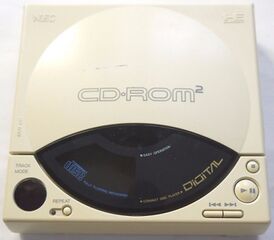Difference between revisions of "CD-ROM²"
From NEC Retro
m |
|||
| Line 13: | Line 13: | ||
}} | }} | ||
}} | }} | ||
| − | {{ | + | {{stub}}The '''CD-ROM²''' (シーディーロムロム, officially pronounced "CD-ROM-ROM") is an add-on for the [[PC Engine]] allowing the console to run games from CD-ROMs. It was originally released in Japan in December 1988, with its Western equivalent being the [[TurboGrafx-CD]]. |
==Hardware== | ==Hardware== | ||
| − | Unlike most of its competitors, particularly the Sega Mega-CD (from 1991) and the likes of the Neo Geo CD (1994) or Atari Jaguar CD (1995), the CD-ROM² is by default, a regular | + | Unlike most of its competitors, particularly the Sega Mega-CD (from 1991) and the likes of the Neo Geo CD (1994) or Atari Jaguar CD (1995), the CD-ROM² is by default, a regular audio CD-ROM player. Plugged into the mains and a pair of speakers or headphones, the CD-ROM² functions as an entirely separate device and theoretically does not need to be concerned with video games at all (which is not dissimilar to earlier home computers reliant on compact cassettes). |
For the CD-ROM² to become a PC Engine accessory, it requires an [[Interface Unit]] (originally sold separately, later bundled with the CD-ROM²), which makes use of a special expansion port on the back of the device to communicate with the PC Engine console. Playing games, however, requires the use of a [[System Card]], which will provide the combined unit with instructions on how to interact with itself, and allow it access to more ROM and RAM. | For the CD-ROM² to become a PC Engine accessory, it requires an [[Interface Unit]] (originally sold separately, later bundled with the CD-ROM²), which makes use of a special expansion port on the back of the device to communicate with the PC Engine console. Playing games, however, requires the use of a [[System Card]], which will provide the combined unit with instructions on how to interact with itself, and allow it access to more ROM and RAM. | ||
| − | If the console of choice doesn't physically fit in the Interface | + | If the console of choice doesn't physically fit in the Interface Unit (e.g. a [[PC Engine SuperGrafx]]), the [[RAU-30]] is also an option to communicate with a CD-ROM². |
CD-ROM² units are were also an option for the [[PC-8801 MC]]. The units which shipped with PC-8801 MCs are identical to their PC Engine counterparts, albeit with the "²" removed. | CD-ROM² units are were also an option for the [[PC-8801 MC]]. The units which shipped with PC-8801 MCs are identical to their PC Engine counterparts, albeit with the "²" removed. | ||
| − | As time moved on, there became less of a need for a stand-alone CD-ROM². The [[Super CD-ROM²]] offers more functionality and products such as the [[PC Engine Duo]] or [[LaserActive]] have the data found on | + | As time moved on, there became less of a need for a stand-alone CD-ROM². The [[Super CD-ROM²]] offers more functionality and products such as the [[PC Engine Duo]] or [[LaserActive]] have the data found on System Cards built-in. |
==Magazine articles== | ==Magazine articles== | ||
Latest revision as of 12:04, 27 February 2023
- This article is for the CD-ROM² accessory. For the CD-ROM² format, see CD-ROM² systems.

| |||||||||||||||
| CD-ROM² | |||||||||||||||
|---|---|---|---|---|---|---|---|---|---|---|---|---|---|---|---|
| Manufacturer: NEC Home Electronics | |||||||||||||||
|
This short article is in need of work. You can help NEC Retro by adding to it.
The CD-ROM² (シーディーロムロム, officially pronounced "CD-ROM-ROM") is an add-on for the PC Engine allowing the console to run games from CD-ROMs. It was originally released in Japan in December 1988, with its Western equivalent being the TurboGrafx-CD.
Hardware
Unlike most of its competitors, particularly the Sega Mega-CD (from 1991) and the likes of the Neo Geo CD (1994) or Atari Jaguar CD (1995), the CD-ROM² is by default, a regular audio CD-ROM player. Plugged into the mains and a pair of speakers or headphones, the CD-ROM² functions as an entirely separate device and theoretically does not need to be concerned with video games at all (which is not dissimilar to earlier home computers reliant on compact cassettes).
For the CD-ROM² to become a PC Engine accessory, it requires an Interface Unit (originally sold separately, later bundled with the CD-ROM²), which makes use of a special expansion port on the back of the device to communicate with the PC Engine console. Playing games, however, requires the use of a System Card, which will provide the combined unit with instructions on how to interact with itself, and allow it access to more ROM and RAM.
If the console of choice doesn't physically fit in the Interface Unit (e.g. a PC Engine SuperGrafx), the RAU-30 is also an option to communicate with a CD-ROM².
CD-ROM² units are were also an option for the PC-8801 MC. The units which shipped with PC-8801 MCs are identical to their PC Engine counterparts, albeit with the "²" removed.
As time moved on, there became less of a need for a stand-alone CD-ROM². The Super CD-ROM² offers more functionality and products such as the PC Engine Duo or LaserActive have the data found on System Cards built-in.
Magazine articles
- Main article: CD-ROM²/Magazine articles.
Physical scans
| CD-ROM² systems |
|---|
| CD-ROM² (1988) | Super CD-ROM² (1991) | Arcade CD-ROM² (1994) |
| Hardware |
| CD-ROM² (Interface Unit | RAU-30) (1988) | TurboGrafx-CD (1989) | PC Engine Duo (1991) | Super CD-ROM² (Super CD-ROM² Adaptor) (1991) | TurboDuo (1992) | PC Engine Duo-R (1993) | LaserActive (1993) |
| System Cards |
| System Card | Super System Card | Arcade Card Pro/Duo |
| Games Express CD Card |
